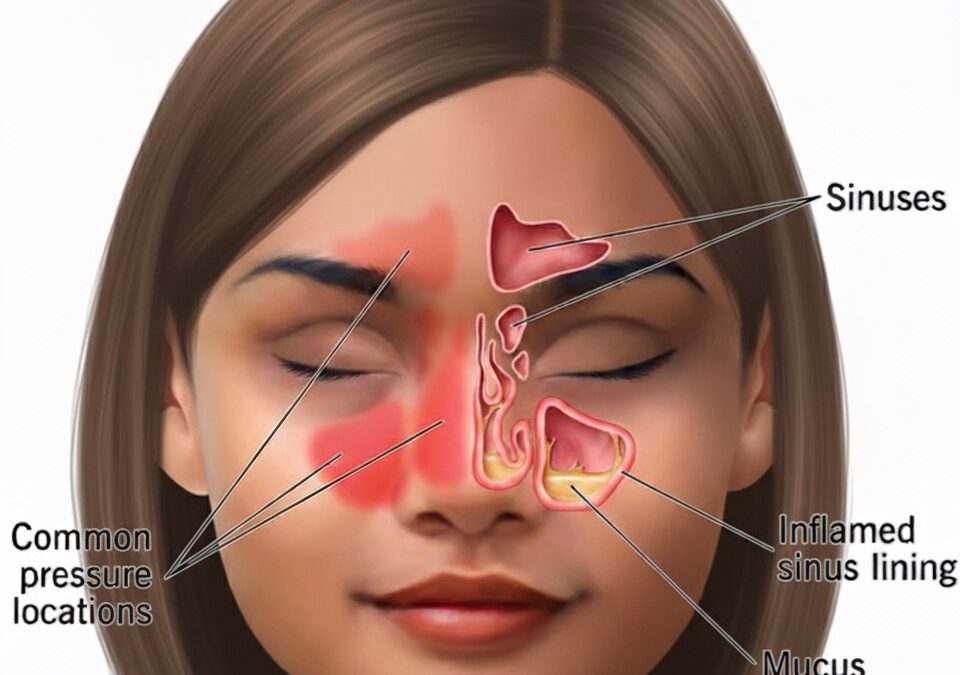ไซนัสคืออะไร ?และเกิดอะไรขึ้นเมื่ออักเสบ? มาดูกันเลยครับ
ปรึกษาหมอกัณฒิภัสส์
✅ไซนัส คือ โพรงอากาศ ที่อยู่ภายในกระดูกใบหน้าของเรา ซึ่งอยู่รอบ ๆ โพรงจมูก (บริเวณแก้ม หน้าผาก ระหว่างตา และหลังจมูก) โพรงเหล่านี้มีหน้าที่ช่วยปรับอุณหภูมิและความชื้นของอากาศที่เราหายใจเข้าไป และผลิตเมือกเพื่อดักจับสิ่งแปลกปลอม
✅เมื่อเกิดการอักเสบติดเชื้อ (มักเกิดตามหลังไข้หวัด) เยื่อบุภายในไซนัสจะบวม ทำให้รูระบายของไซนัสที่เชื่อมต่อกับโพรงจมูกเกิดการอุดตัน สารคัดหลั่ง (น้ำมูก/เมือก) จึงคั่งค้างอยู่ภายในโพรงไซนัสและกลายเป็นหนอง นำไปสู่การเติบโตของเชื้อโรค ซึ่งทำให้เกิดอาการของไซนัสอักเสบตามมา
✅อาการที่สังเกตได้ (อาการหลัก 4 อย่าง) นะครับ
-
น้ำมูกข้น หรือเสมหะไหลลงคอ (Post-nasal Drip): มักมีสีเหลืองหรือเขียว ซึ่งบ่งบอกถึงการติดเชื้อ
-
คัดจมูก/หายใจลำบาก: รู้สึกเหมือนจมูกตัน หายใจเข้า-ออกไม่สะดวก
-
ปวด หรือรู้สึกตึงบริเวณใบหน้า: โดยเฉพาะบริเวณรอบดวงตา แก้ม หน้าผาก หรือรู้สึกปวดไปถึงฟัน (อาการมักแย่ลงเมื่อก้มศีรษะ)
-
ความสามารถในการรับกลิ่นลดลง (Hyposmia): หรืออาจไม่ได้กลิ่นเลย
✅นอกจากนี้ อาจมีอาการอื่นร่วมด้วย เช่น มีไข้ ปวดศีรษะ ไอเรื้อรัง หรือมีกลิ่นปาก
การดูแลตัวเองเบื้องต้น
โดยมีเป้าหมายเพื่อช่วยลดอาการบวมและช่วยให้สารคัดหลั่งระบายออก
- ล้างจมูกด้วยน้ำเกลือ: เป็นวิธีที่มีประสิทธิภาพสูงในการชำระล้างเมือกและเชื้อโรคในโพรงจมูกและไซนัส ทำให้อาการคัดจมูกดีขึ้น
- พักผ่อนให้เพียงพอและดื่มน้ำมาก ๆ: เพื่อให้ร่างกายแข็งแรงและช่วยให้เมือกในไซนัสไม่ข้นเหนียวจนเกินไป
- ใช้ยาแก้ปวด/ลดไข้: เช่น พาราเซตามอล หรือไอบูโพรเฟน เพื่อบรรเทาอาการปวดศีรษะและปวดใบหน้า
- หลีกเลี่ยง: การอยู่ในที่ที่มีควัน ฝุ่น มลภาวะ หรือควันบุหรี่ ซึ่งจะกระตุ้นให้เยื่อบุจมูกอักเสบมากขึ้น
✅เมื่อไหร่ควรไปพบแพทย์?
ควรไปพบแพทย์เพื่อตรวจวินิจฉัยและรับการรักษาที่เหมาะสม:
- อาการไม่ดีขึ้นหลังจากดูแลตัวเองอย่างเต็มที่เป็นเวลา 7 วัน
- อาการแย่ลงอย่างรวดเร็ว หรืออาการกลับมาเป็นหนักขึ้นหลังอาการเริ่มดีขึ้นแล้ว
- มีไข้สูง หรือมีอาการปวดศีรษะ/ปวดใบหน้ารุนแรง
- มีอาการแทรกซ้อนที่น่ากังวล: เช่น บวมแดงรอบดวงตา การมองเห็นเปลี่ยนไป สับสน หรือคอแข็ง (แม้จะพบได้น้อยมาก แต่เป็นสัญญาณของภาวะติดเชื้อลุกลามไปยังอวัยวะข้างเคียง)
?แพทย์จะพิจารณาให้ยาปฏิชีวนะก็ต่อเมื่อสงสัยว่ามีการติดเชื้อแบคทีเรียร่วมด้วย
?การเข้าใจและรู้วิธีดูแลอาการเบื้องต้นจะช่วยให้คุณจัดการกับไซนัสอักเสบได้อย่างมีประสิทธิภาพ และรู้ว่าเมื่อไหร่ที่จะพบผู้เชี่ยวชาญครับ
โทร 0833309366
เปิดทุกวัน
จันทร์ ถึง พุธ 16.30 – 20.00 น.
พฤหัส ถึง ศุกร์. 8.00 – 20.00 น.
วันเสาร์ 8.00 – 12.00 น.
อาทิตย์ 8.00 – 16.00 น.
Monday – Wednesday 4.30 pm to 8 pm
Thursday – Friday 8 am to 8 pm
Saturday 8 am to noon
Sunday 8 am to 4 pm
แผนที่ google map
+++++++++++++++++++++++++++++++++
Sinusitis: Understanding and How to Take Care of Yourself?
What are sinuses? ?And what happens when they become inflamed? Let’s take a look.
✅Sinuses are air-filled cavities located within the facial bones, surrounding the nasal cavity (on the cheeks, forehead, between the eyes, and behind the nose). These cavities help regulate the temperature and humidity of the air we breathe and produce mucus to trap foreign objects.
✅When an infection occurs (usually following a cold), the lining of the sinuses swells, blocking the drainage holes in the sinuses that connect to the nasal cavity. This causes secretions (mucus/mucus) to become trapped in the sinuses and turn into pus, leading to the growth of germs, leading to the symptoms of sinusitis.
✅These are the four main symptoms:
Thick nasal discharge or postnasal drip: Often yellow or green in color, indicating infection.
Nasal congestion/difficulty breathing: Feeling congested, making it difficult to breathe in and out.
Facial pain or tightness: Especially around the eyes, cheeks, forehead, or pain that extends to the teeth. (Symptoms often worsen when the head is bent.)
Decreased sense of smell (Hyposmia): You may not smell at all.
✅Other symptoms may include fever, headache, chronic cough (especially at night), or bad breath.
Self-care measures
The goal is to reduce swelling and facilitate drainage.
Saline nasal irrigation: This is a highly effective way to flush out mucus and germs from the nasal cavity and sinuses, improving nasal congestion.
Get plenty of rest and fluids: This helps to strengthen the body and prevent mucus from thickening in the sinuses.
Take pain relievers/fever reducers, such as paracetamol or ibuprofen, to relieve headache and facial pain.
Avoid exposure to smoke, dust, pollution, or cigarette smoke, which can further inflame the nasal mucosa.
✅When should you see a doctor?
See a doctor for proper diagnosis and treatment:
Symptoms do not improve after 7 days of careful self-care.
Symptoms worsen rapidly, or symptoms return after initial improvement.
High fever or severe headache/facial pain.
Worrying complications include swelling and redness around the eyes, changes in vision, confusion, or a stiff neck (although rare, these are signs of an infection spreading to nearby organs).
? Your doctor will only prescribe antibiotics if a bacterial infection is suspected.
? Understanding and knowing how to manage your symptoms will help you effectively manage your sinusitis and know when to see a specialist.



